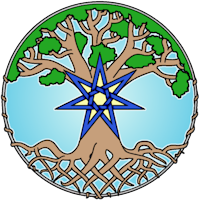If you’re reading this, you’ve probably seen the craft name I use at some point. I generally use my given first name, and a matronymic: Nic Bhé Chuille. This is a name I was told to use more publicly, as I’ve been using the matronymic for a while in the Otherworlds on account of my relationship with a fairy queen I publicly call “Starflower”, who I understand to be the daughter of the goddess Bé Chuille. UPG alert on that whole bit, because there is no lore about Bé Chuille’s children, and honestly UPG alert on most of the rest of this blog, because there just isn’t a lot of lore. So if that’s not your thing, read the next paragraph and then wander off or something.
The lore that we do have for Bé Chuille and Dinand is pretty sparse, and the main myth they appear in is the Lebor Gabála Érenn, commonly called the Book of Invasions in English. They are referred to as “she-farmers” (in most translations) and as daughters of the goddess Flidais near the beginning of the section on the Tuatha Dé Dannan, though the word translated as “she-farmers” bantuathig,¹ may instead mean a type of witch associated with north-turning or anti-clockwise movement (and likely with what we might call cursing and banework), which elsewhere is spelled bantuathaig². In the Cath Maige Tuired, where Lugh asks “his two witches” what power they will bring to the battle, the original text uses the second word/spelling, and most translators give it as “witches”. They respond “We will use our sorcery on the trees and stones and clods of earth, so they will be a host under arms against them and they will flee in fright and terror”.³ Bé Chuille and Dinand also appear in the Banshenchus (Lore of Women), named as sorceresses, along with Nemain, Morrigan, Badb, Macha and Etain, and in the Metrical Dinsenchas (Lore of Places) as adversaries of an evil Greek witch named Carmun. They are probably also meant to be the two “witches of Lugh” who are also called daughters of Flidais in the Oidheadh Chloinne Tuireann (Fate of the Children of Turenn), where he gets revenge on the men who killed his father. And that’s basically it! Not a lot to go on.
So – UPG from here on out.
While the etymology for Bé Chuille’s name isn’t known for sure, and is made more complicated by the fact that Old Irish spelling and diacritical mark usage wasn’t standardized, Morgan Daimler suggests “woman of destruction”,⁴ and while I’m not a trained linguist, I personally wonder if it might not be related to modern Irish cuil, a fly or an angry or aggressive appearance.⁵ Those do seem to fit my experience of her magic – she seems to be particularly adept at magic relating to decay. Partly because of that, I associate her most with the season of autumn. She also seems to specialize in certain types of battle sorcery, especially related to land and to a lesser extent freshwater, as in the Cath Maige Tuired, where she raised the sods of the plain to fight on the side of the Tuatha Dé Danann. When I journey to see her, I meet her most often in a dark autumn pine forest on the edge of a river, and I associate her with those shades of dark green and black-brown, and with thorny thicket plants, fungus, and the cycles of autumn decay. When I see her, she is usually light complexioned, with dark wavy hair. I find her to be intense but somewhat lively, though quick to anger. Devotees of the Morrigan may feel some recognition at her untalkative and yet very expressive manner.
Dinand is possibly even more obscure, as there are three spellings used (Dinand, or Dianann, or Dinann), and it’s very hard to say what the etymological root might be. She is often there when I journey to see her sister, and she seems to be the elder of the two. I see her as light complexioned and dark haired as well, though her hair is thicker and less wavy. I associate her with the same dark autumn pine forest, but she seems to have more affinity with the river running through it, and so her colors in my practice are dark green and dark blue. She seems to also practice destructive magic, and of course the battle sorcery from the Cath Maige Tuired, and I associate her magic with the fierceness of river rapids, the water crashing against large boulders in its path. Like her sister, she is intense, and sparing with her words.
I tend to honor them together most of the time, and for offerings I suggest woodsy scented candles, coniferous or thorny plants, river stones, and I’ve yet to meet an Irish deity that doesn’t like whisky! For non-consumable offerings, maybe try going for a walk in the woods, swimming or boating in a river (safely!), bouldering, cleaning up trash in those areas, removing invasive plants, composting, fermentation, martial arts practice, or mastering a magical skill.
Let me know if you’ve met these goddesses – I’d love to hear others’ experiences! I really haven’t seen much of anyone discuss them in a modern pagan context.
Notes:
- Full text is available online here: https://celt.ucc.ie/published/G800011A/text001.html . P. 35
- Full text is available online here: https://celt.ucc.ie/published/G300011.html . P. 92
- From Morgan Daimler’s translated volume “Cath Maige Tuired: A Full English Translation”, independently published, 2020. Lines 116-117. (Available on Amazon.) See also Daimler’s footnote #77 for more information on “bantuathaig”.
- Daimler, “Cath Maige Tuired”, footnote #76.
- https://www.teanglann.ie/en/fgb/cuil
